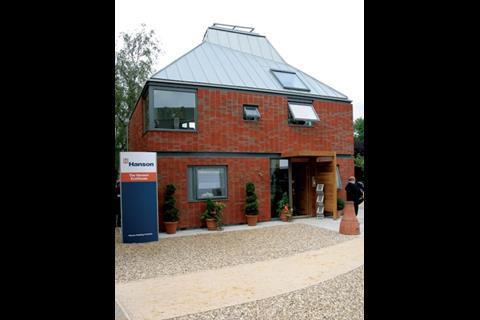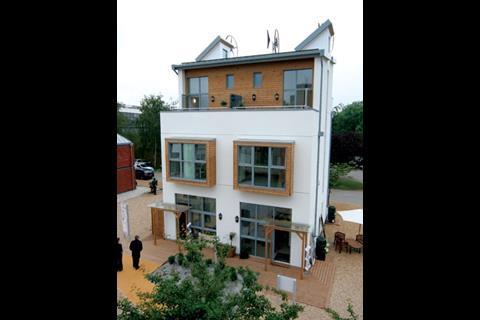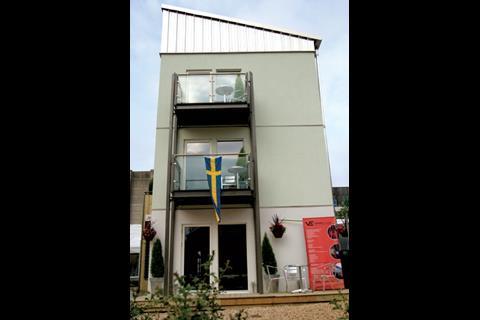BRE's latest information paper on Innovation Park homes explores carbon-cutting opportunities in less obvious areas
It's easy to assume that the Code for Sustainable Homes is all about reducing carbon emissions and water consumption. But the code also offers rich rewards in a number of other areas, which designers will find well worth pursuing.
The fourth and final instalment of BRE's information papers on the lessons learned from the dwellings at its Innovation Park, rated between levels four and six against the code, highlights what can be achieved. According to Christopher Gaze of BRE, there are easy wins if you plan from early in the design process. “Architects can deliver a lot of credits by looking in areas such as layout and construction,” he says.
Architecture
With the exception of the Hanson EcoHouse, all four houses at the Innovation Park are more than two storeys and feature a mono pitched roof. There's a simple reason for this. Credits are awarded for efficient land use - a net internal floor area to net internal ground floor area of 2.5:1 gets one credit, or 3:1 gets two credits. And mono pitched roofs lend themselves to the mounting of solar thermal collectors and photovoltaic arrays.
Balconies also feature prominently and provide private or semi-private space credits and in some cases also serve as solar shading. The ecoTech home uses a self-supporting balcony, overcoming any issues of thermal bridging or air leakage that might occur by penetrating the building fabric.
Placing living spaces and kitchens upstairs and bedroom downstairs is another popular solution. “There's an interesting argument in terms of daylighting for doing this,” says Gaze. Credits are given for daylighting, particularly where rooflights are used to complement traditional windows, which maximise the average daylight factor and the amount of direct light from the sky on working planes. However, this can conflict with the building's thermal performance and issues with solar gain, as Kingspan Offsite found. “Having the bedrooms downstairs also keeps them cooler,” adds Gaze.
Other, more subtle sustainable features include permeable paving, which as well as being a component of a sustainable urban drainage system also allows for the collection of water into a tank and provides a location for the pipes for any ground source heat pump used.
Sound insulation
Sound insulation is one area well worth highlighting, says Gaze. Detached houses achieve the full four credits for sound performance available under the Code for Sustainable Homes. However, attached dwellings that can outperform the acoustic requirements for walls and floors in the ��ɫ����TV Regulations by 8dB will get a full four credits. “That's the same as you might achieve with Lifetime Homes,” says Gaze.
The Sigma Home was the only attached dwelling at the Innovation Park, and has walls conforming to Robust Details - a route for complying with Part E of the ��ɫ����TV Regulations that uses standard designs and avoids the need for on-site pre-completion testing. The best-performing walls that feature in Robust Details outperform ��ɫ����TV Regulations by 5dB.
Low-energy appliances
Specifying low-energy appliances is an easy win, with two of the houses getting full credits under the Ene 5 section of the code simply by selecting fridges and freezers with an A+ rating and washing machines with an A rating and providing occupiers with information on the energy labelling scheme.
Maximum credits were also achieved for low-energy internal and external lighting. According to Gaze, many housebuiliders and registered social landlords do not have experience of providing white goods, but this is an area where they can pick up credits.
Security
All the houses achieved credits for having security complying with section two of Secured by Design - the police's initiative for designing out crime. This means following the recommendations of an architectural liaison officer or crime prevention design adviser from the police, which includes having doors in accordance with PAS 24-1 and downstairs windows in accordance with BS 7950: 1997.
Credits are also given for appropriate locks, chains, limiters, viewers, letter plates and external lighting - all of which most occupiers would expect.
Documentation and construction
Even now, many specifiers find it difficult to find manufacturers that can ensure there is a thorough documentation trail to demonstrate responsible sourcing of materials and products. Examples of materials for which sourcing was problematic to document include kitchen counter tops, and insulation material within the ground source heat pump.
This does not mean that there were problems with the materials, but no documentation to support where they had come from. It is clear that, when working with new suppliers, the environmental chain of custody paperwork should ideally be established before orders are placed.
Interestingly, fast-track projects of less than six weeks cannot be registered with the Considerate Constructors Scheme. The ecoTech Organics House fell into this category and was unable to attain the available credits.
Postscript
Copies of the BRE information papers covering lessons learned from the Code for Sustainable Homes dwellings at its Innovation Park can be obtained from the BRE bookshop.































No comments yet